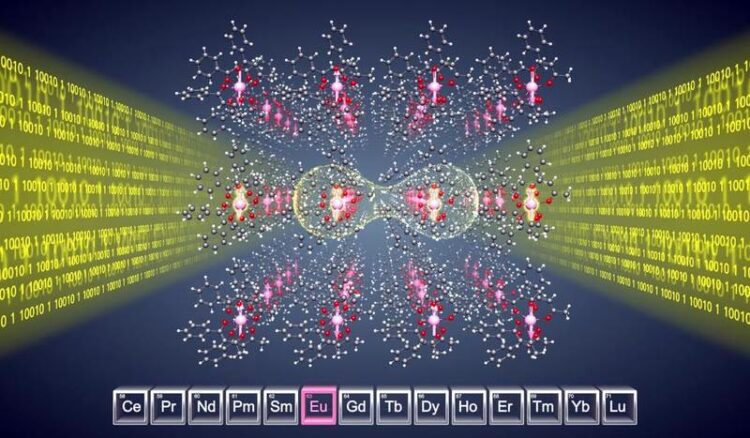Quantum information: Light from rare-earth molecules

Photon-spin interface with the europium molecule crystal for entanglement of nuclear spin qubits (arrows) with the help of photons (yellow).
Credit: Christian Grupe, KIT
Novel material with promising properties for quantum computers and networks discovered – KIT researchers report in nature.
Quantum information will revolutionize not only research and industry, but also our everyday life. Among others, it promises enormous progress in the simulation of materials and processes, which will push the development of new medical substances, the improvement of batteries, transport planning, and secure information and communication. A quantum bit (qubit) can assume many different states between 0 and 1 at the same time. This so-called quantum superposition enables massively parallel processing of data. As a result, computing capacity of quantum computers will increase exponentially compared to digital computers.
To carry out computing operations, however, the superposition states of a qubit have to persist for a certain time. In quantum research, this is referred to as coherence lifetime. Nuclear spins, i.e. angular momentums of atomic nuclei, in molecules enable superposition states with long coherence lifetimes, because nuclear spins are shielded well from the environment and protect qubits against external impacts.
Effective Light/Nuclear Spin Interface
“For practical applications, we have to be able to store, process, and distribute quantum states,” says Professor Mario Ruben, Head of the Molecular Quantum Materials Group of KIT’s Institute for Quantum Materials and Technologies (IQMT) and of the European Center for Quantum Sciences – CESQ of Strasbourg University. “For this, we have now identified a promising novel type of material: A europium molecule containing nuclear spins. Europium belongs to the rare-earth metals.” The team of Professors Mario Ruben and David Hunger from the IQMT and Dr. Philippe Goldner from the École nationale supérieure de Chimie de Paris (Chimie ParisTech – PSL University; Centre national de la recherche scientifique; CNRS) present this innovative material in Nature.
The molecule is structured such that it exhibits luminescence in case of laser excitation. This means that it emits photons carrying the nuclear spin information. By means of specific laser experiments, an effective light/nuclear spin interface can be produced. The work covers the addressing of nuclear spin levels with the help of photons, coherent storage of photons, and the execution of first quantum operations.
High Density of Qubits
To execute useful quantum operations, many qubits entangled by quantum mechanics are required. For this, the qubits must interact with each other. The researchers from Karlsruhe, Strasbourg, and Paris have proved that europium ions in molecules can couple via electric stray fields, thus enabling future entanglement and, hence, quantum information processing. As the molecules are structured with atom precision and arrange in exact crystals, a high qubit density can be reached.
Another aspect relevant to practical applications is the addressability of individual qubits. Optical addressing increases the readout speed and interfering electrical feeds can be prevented. Frequency separation allows to individually address a number of molecules. Compared to previous projects, the work reported here reaches an about thousand times better optical coherence in a molecular material. In this way, nuclear spin states can be manipulated optically in a specific way.
A Step towards the Quantum Internet
Light is also suited for distributing quantum information over larger distances to connect quantum computers or to securely transmit information. This might be achieved by future integration of the novel europium molecule in photonic structures to enhance transitions. “Our work represents an important step towards quantum communication architectures with rare-earth molecules as a basis for a quantum internet,” Professor David Hunger, IQMT, says. (or)
Original Publication
Diana Serrano, Kuppusamy Senthil Kumar, Benoît Heinrich, Olaf Fuhr, David Hunger, Mario Ruben, Philippe Goldner: Rare-earth Molecular Crystals with Ultra-narrow Optical Linewidths for Photonic Quantum Technologies. Nature, 2021. DOI: 10.1038/s41586-021-04316-2.
https://www.nature.com/articles/s41586-021-04316-2
Contact for This Press Release
Margarete Lehné, Press Officer, phone: +49 721 608-41157, email: margarete.lehne@kit.edu
Being “The Research University in the Helmholtz-Association,“ KIT creates and imparts knowledge for the society and the environment. It is the objective to make significant contributions to the global challenges in the fields of energy, mobility and information. For this, about 9,600 employees cooperate in a broad range of disciplines in natural sciences, engineering sciences, economics, and the humanities and social sciences. KIT prepares its 23,300 students for responsible tasks in society, industry, and science by offering research-based study programs. Innovation efforts at KIT build a bridge between important scientific findings and their application for the benefit of society, economic prosperity, and the preservation of our natural basis of life. KIT is one of the German universities of excellence.
Journal: Nature
DOI: 10.1038/s41586-021-04316-2
Article Title: Ultra-narrow optical linewidths in rare-earth molecular crystals
Article Publication Date: 9-Mar-2022
All latest news from the category: Information Technology
Here you can find a summary of innovations in the fields of information and data processing and up-to-date developments on IT equipment and hardware.
This area covers topics such as IT services, IT architectures, IT management and telecommunications.
Newest articles

Innovative 3D printed scaffolds offer new hope for bone healing
Researchers at the Institute for Bioengineering of Catalonia have developed novel 3D printed PLA-CaP scaffolds that promote blood vessel formation, ensuring better healing and regeneration of bone tissue. Bone is…

The surprising role of gut infection in Alzheimer’s disease
ASU- and Banner Alzheimer’s Institute-led study implicates link between a common virus and the disease, which travels from the gut to the brain and may be a target for antiviral…

Molecular gardening: New enzymes discovered for protein modification pruning
How deubiquitinases USP53 and USP54 cleave long polyubiquitin chains and how the former is linked to liver disease in children. Deubiquitinases (DUBs) are enzymes used by cells to trim protein…



